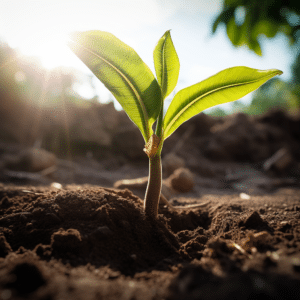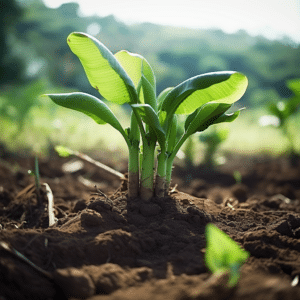Are you interested in growing your own banana tree? It’s a rewarding endeavor that can yield delicious fruit and add a tropical touch to your garden. This guide will walk you through the process step by step, from choosing the right type of banana plant to harvesting your bananas.
Understanding Banana Plants

Before you start planting, it’s important to understand what makes a banana plant unique. Despite often being referred to as a tree, the banana plant is actually a herbaceous plant. It’s the world’s largest herb, with some varieties reaching up to 25 feet in height.
Banana plants are native to Southeast Asia but are now grown in many tropical and subtropical regions around the world. They thrive in warm, humid climates with temperatures between 78 and 86 degrees Fahrenheit. However, some varieties can tolerate cooler temperatures.
Types of Banana Plants
There are over 1,000 varieties of banana plants, but not all of them produce the sweet, edible fruit we’re familiar with. Some produce inedible fruit, while others are grown for their ornamental value. The most common type of banana plant for home growers is the Dwarf Cavendish, which produces sweet, edible bananas and grows well in containers.
Other popular varieties include the Ice Cream banana, which has a blueish skin and a flavor reminiscent of vanilla ice cream, and the Red banana, which has a sweet, creamy flesh. Choosing the right variety for your needs and climate is an important first step in growing a banana plant.
Planting Your Banana Plant
Once you’ve chosen your banana plant variety, it’s time to start planting. Banana plants can be grown from seeds, but it’s much easier and faster to grow them from pups or suckers, which are small plants that grow from the base of a mature banana plant.
Choose a location with full sun and well-draining soil. Banana plants prefer slightly acidic to neutral soil with a pH between 5.5 and 7.0. If your soil is heavy clay or sandy, amend it with organic matter to improve its structure and fertility.
Steps to Plant a Banana Plant
- Dig a hole twice as wide and deep as the root ball of your banana plant.
- Place the plant in the hole, making sure the top of the root ball is level with the soil surface.
- Backfill the hole with soil, firming it gently around the base of the plant.
- Water the plant thoroughly.
After planting, apply a layer of mulch around the base of the plant to conserve moisture and suppress weeds. Keep the soil consistently moist but not waterlogged, as banana plants are susceptible to root rot.
Caring for Your Banana Plant
Banana plants require regular care to thrive and produce fruit. They need plenty of water and nutrients, especially potassium, which is essential for fruit production.
Fertilize your banana plant regularly with a balanced fertilizer that contains potassium. You can also add organic matter, such as compost or well-rotted manure, to provide additional nutrients.
Pruning and Propagation
Banana plants produce pups or suckers that can be removed and planted to propagate new plants. However, too many pups can drain energy from the mother plant and reduce fruit production. Prune off any pups that are smaller than one foot in height or that grow more than two feet away from the mother plant.
After a banana plant has fruited, it will die back. Cut it down to ground level and allow a pup to take its place. This cycle of growth and death is a natural part of the banana plant’s life cycle.
Harvesting Your Bananas

It can take anywhere from nine months to a year for a banana plant to produce fruit, depending on the variety and growing conditions. You’ll know it’s time to harvest when the bananas turn from dark green to light green or yellow, depending on the variety.
Harvest the entire bunch of bananas at once by cutting it off with a sharp knife. Leave a few inches of stem attached to the bananas to make them easier to handle. After harvesting, allow the bananas to ripen at room temperature. They’ll be ready to eat when they’re slightly soft to the touch and the skin is yellow or, in the case of some varieties, red or blue.
Common Problems and Solutions
Like all plants, banana plants can be affected by pests and diseases. Common pests include aphids, spider mites, and nematodes, which can be controlled with regular applications of insecticidal soap or other organic pest control methods.
Banana plants can also be affected by fungal diseases, such as Panama disease and black Sigatoka. These diseases can be prevented by practicing good sanitation, such as removing and disposing of infected plants and debris, and by applying organic fungicides.
Overcoming Climate Challenges
If you live in a cooler climate, you can still grow banana plants with a bit of extra care. Choose a cold-hardy variety, such as the Japanese Fiber Banana or the Hardy Banana, and provide it with a sheltered location and plenty of mulch to protect the roots from freezing temperatures.
You can also grow banana plants in containers and bring them indoors during the winter. Keep them in a sunny location and reduce watering during the winter months.
Conclusion
Growing a banana plant can be a rewarding experience, providing you with a taste of the tropics and a sense of accomplishment. With the right care and attention, you can enjoy your own homegrown bananas in no time. So why not give it a try? You might just find that you have a green thumb for tropical plants.